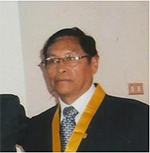Dr. Jorge Chancos’ perspective: Appreciation, contributions, and influences to Peruvian geography
DOI:
https://doi.org/10.15381/espiral.v2i3.18454Keywords:
Geographic thinking, space, perspective, basin, territoryAbstract
Jorge Chancos Pillaca is a renowned Peruvian geographer. He was born in huancapi district, Fajardo province, Ayacucho in 1937. He is the author of great research embodied in his thesis is one of the most relevant his doctoral thesis: Melting the glaciers of the Pariaqaqa Range and their influence on the origin and flow of the Rimac River (2011) sponsored by the Lima Geographical Society. In addition to his latest most notable book Theory of Geography and Geographer (2019) where he develops geographical thinking over time. In this interview, aimed at every national and foreign public interested in learning about the evolution of Peru’s geographical thinking, Jorge Chancos Pillaca details different aspects of Peruvian geography highlighting geographical thinking since the time of Tawantinsuyo. It makes known its beginnings in Geography in the Dean of America, provides a definition of geography, including geographers who influenced its formation, highlighting the fact that we met Milton Santos; it also explains why I am inclined to conduct watershed studies, his opinion regarding the changes in the modeling of the Peruvian territory and details some chapters of his great book “Theory of Geography and Geographers”, concluding with an opinion on how important the geographer is due to its multidisciplinary and integrative nature.

Downloads
Published
Issue
Section
License
Copyright (c) 2020 Angie Dayana Condori Lazo, Bruno Jahiro Pintado Caparachin

This work is licensed under a Creative Commons Attribution-NonCommercial-ShareAlike 4.0 International License.
LOS AUTORES RETIENEN SUS DERECHOS:
a. Los autores retienen sus derechos de marca y patente, y también sobre cualquier proceso o procedimiento descrito en el artículo.
b. Los autores retienen el derecho de compartir, copiar, distribuir, ejecutar y comunicar públicamente el artículo publicado en la revista Espiral (por ejemplo, colocarlo en un repositorio institucional o publicarlo en un libro), con un reconocimiento de su publicación inicial en la revista Espiral.
c. Los autores retienen el derecho a hacer una posterior publicación de su trabajo, de utilizar el artículo o cualquier parte de aquel (por ejemplo: una compilación de sus trabajos, notas para conferencias, tesis, o para un libro), siempre que indiquen la fuente de publicación (autores del trabajo, revista, volumen, número y fecha).





